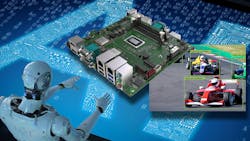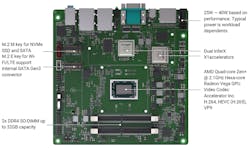Mini-ITX Motherboard Packs Two AI Accelerator Chips
What you’ll learn
- What’s inside the InferX Hawk?
- What applications does it target?
- What makes the InferX X1 accelerator unique?
I’m looking forward to checking out the InferX Hawk from Flex Logix (Fig. 1). The Mini-ITX motherboard has a quad-core, AMD Zen+ host processor with a Radeon Vega GPU and video codec accelerator. However, the machine-learning (ML) heavy lifting is done by a pair of Flex Logix InferX X1 artificial-intelligence (AI) accelerators that can be used individually or in tandem. It brings ML/AI acceleration to the edge in a complete package.
The InferX X1 chip utilizes multiple single-dimensional Tensor processors that can be configured on the fly (Fig. 2). It supports a high-precision Winograd acceleration option that increases system utilization and overall efficiency. The reconfiguration feature allows for support of two- and three-dimensional tensors.
The chip also incorporates embedded FPGA (eFPGA) logic, opening the door to further customization. With the on-chip memory and reconfigurable fabric, intermediate results can be kept locally instead of bringing off-chip memory into play. The system is able to handle standard conv2d models as well as depth-wise conv2d models. Each chip can manage multiple models depending on their size, or the two chips may be combined to deal with one large model.
Almost any ML model works with the InferX X1 chips, but video processing is an area where it excels. This includes applications such as object recognition within a video stream. Video streams are normally provided via USB or gigabit Ethernet (GbE). Taking this into consideration, the AMD processor was paired with the two InferX X1 chips to balance the overall system throughput and take advantage of AMD’s video-processing hardware capabilities.
The motherboard supports up to 32 GB of DDR4 SO-DIMM memory. There’s an M.2 M key and an M.2 E key socket—the former targets NVMe SSDs, while the latter supports smaller peripherals such as a wireless adapter. The backplane features a pair of DisplayPort sockets, two GbE sockets, two serial ports, plus five USB ports for USB 2.0, 3.1, and 3.2 (Type-C) connections. The system requires from 25 to 40 W of power depending on the workload.
The system is supported by Flex Logix’s EasyVision, which includes pretrained and configured models for video applications such as face-mask and license-plate identification. In addition, it can check for PCB defects and perform battery inspection. The EasyVision models work with the InferX Model Development Kit (MDK) and the Run Time Kit (RTK).
About the Author
William G. Wong
Senior Content Director - Electronic Design and Microwaves & RF
I am Editor of Electronic Design focusing on embedded, software, and systems. As Senior Content Director, I also manage Microwaves & RF and I work with a great team of editors to provide engineers, programmers, developers and technical managers with interesting and useful articles and videos on a regular basis. Check out our free newsletters to see the latest content.
You can send press releases for new products for possible coverage on the website. I am also interested in receiving contributed articles for publishing on our website. Use our template and send to me along with a signed release form.
Check out my blog, AltEmbedded on Electronic Design, as well as his latest articles on this site that are listed below.
You can visit my social media via these links:
- AltEmbedded on Electronic Design
- Bill Wong on Facebook
- @AltEmbedded on Twitter
- Bill Wong on LinkedIn
I earned a Bachelor of Electrical Engineering at the Georgia Institute of Technology and a Masters in Computer Science from Rutgers University. I still do a bit of programming using everything from C and C++ to Rust and Ada/SPARK. I do a bit of PHP programming for Drupal websites. I have posted a few Drupal modules.
I still get a hand on software and electronic hardware. Some of this can be found on our Kit Close-Up video series. You can also see me on many of our TechXchange Talk videos. I am interested in a range of projects from robotics to artificial intelligence.



